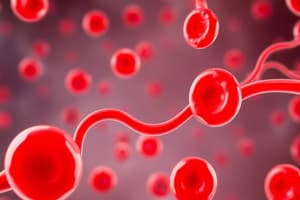Podcast
Questions and Answers
What is the role of GPIIB/IIIA receptors in platelet aggregation?
What is the role of GPIIB/IIIA receptors in platelet aggregation?
- They bind to fibrinogen, allowing platelets to adhere to each other and form a platelet plug. (correct)
- They cleave fibrinogen into fibrin monomers, initiating the formation of a stable clot.
- They bind to collagen at the injury site, initiating the intrinsic pathway of coagulation.
- They bind to tissue factor, activating the extrinsic pathway of coagulation.
Which event directly follows the activation of Factor X in both the intrinsic and extrinsic coagulation pathways?
Which event directly follows the activation of Factor X in both the intrinsic and extrinsic coagulation pathways?
- Formation of the VIIa-TF complex.
- Cleavage of fibrinogen to fibrin.
- Activation of Factor XII.
- Activation of prothrombin by the prothrombinase complex. (correct)
How does the extrinsic pathway of coagulation get initiated?
How does the extrinsic pathway of coagulation get initiated?
- Activation of Factor IX by the IXa-VIIIa complex.
- Binding of Factor VIIa to tissue factor released from damaged cells. (correct)
- Activation of Factor XII by contact with negatively charged surfaces.
- Direct activation of prothrombin by Factor Xa.
Which of the following occurs within the intrinsic pathway of coagulation?
Which of the following occurs within the intrinsic pathway of coagulation?
What is the direct role of the prothrombinase complex in secondary hemostasis?
What is the direct role of the prothrombinase complex in secondary hemostasis?
How does thrombin contribute to its own amplification during the coagulation process?
How does thrombin contribute to its own amplification during the coagulation process?
What is the function of Factor XIIIa in the final stages of secondary hemostasis?
What is the function of Factor XIIIa in the final stages of secondary hemostasis?
Which of the following best describes the relationship between primary and secondary hemostasis?
Which of the following best describes the relationship between primary and secondary hemostasis?
What is the primary role of nitric oxide and prostaglandins in hemostasis following endothelial injury?
What is the primary role of nitric oxide and prostaglandins in hemostasis following endothelial injury?
During primary hemostasis, what is the immediate effect of vascular spasm triggered by endothelial injury?
During primary hemostasis, what is the immediate effect of vascular spasm triggered by endothelial injury?
Which of the following best describes the role of Von Willebrand factor (vWF) in primary hemostasis?
Which of the following best describes the role of Von Willebrand factor (vWF) in primary hemostasis?
What is the significance of platelets expressing the surface protein GPIIB/IIIA during the activation stage of primary hemostasis?
What is the significance of platelets expressing the surface protein GPIIB/IIIA during the activation stage of primary hemostasis?
Which of the following substances released by activated platelets contribute to the positive feedback loop that amplifies platelet activation?
Which of the following substances released by activated platelets contribute to the positive feedback loop that amplifies platelet activation?
How does the change in platelet shape upon activation contribute to the formation of a platelet plug during primary hemostasis?
How does the change in platelet shape upon activation contribute to the formation of a platelet plug during primary hemostasis?
What is the role of calcium released by platelets during the activation stage of primary hemostasis?
What is the role of calcium released by platelets during the activation stage of primary hemostasis?
What distinguishes primary hemostasis from secondary hemostasis in the process of blood clot formation?
What distinguishes primary hemostasis from secondary hemostasis in the process of blood clot formation?
Flashcards
Hemostasis
Hemostasis
The body's mechanism to prevent blood loss when a blood vessel is damaged.
Primary Hemostasis
Primary Hemostasis
Platelets clump together to form a temporary plug at the injury site.
Secondary Hemostasis
Secondary Hemostasis
A protein mesh (fibrin) reinforces the platelet plug, making it more stable.
Vascular Spasm
Vascular Spasm
Signup and view all the flashcards
Endothelin
Endothelin
Signup and view all the flashcards
Von Willebrand Factor
Von Willebrand Factor
Signup and view all the flashcards
GP1B
GP1B
Signup and view all the flashcards
ADP and Thromboxane A2
ADP and Thromboxane A2
Signup and view all the flashcards
Platelet Aggregation
Platelet Aggregation
Signup and view all the flashcards
Extrinsic Pathway
Extrinsic Pathway
Signup and view all the flashcards
Intrinsic Pathway
Intrinsic Pathway
Signup and view all the flashcards
Common Pathway
Common Pathway
Signup and view all the flashcards
Prothrombinase Complex
Prothrombinase Complex
Signup and view all the flashcards
Thrombin's Role
Thrombin's Role
Signup and view all the flashcards
Factor XIIIa
Factor XIIIa
Signup and view all the flashcards
Study Notes
- Hemostasis prevents blood loss when a blood vessel is injured.
- It has two types: primary and secondary.
Primary Hemostasis
- Platelets clump together to form a plug around the injury site.
- Involves 5 steps: endothelial injury, exposure, adhesion, activation, and aggregation.
Endothelial Injury
- Nerves attached to endothelial and smooth muscle cells trigger vascular spasm, narrowing the vessel and reducing blood flow.
- Nitric oxide and prostaglandin secretion decreases, while endothelial cells secrete endothelin, causing smooth muscles to contract.
Exposure
- Collagen beneath the endothelial cells gets exposed.
- Damaged endothelial cells release von Willebrand factor, which binds to the exposed collagen.
Adhesion
- Circulating platelets encounter von Willebrand factor bound to collagen.
- Platelets bind to von Willebrand factor via the surface protein GP1B.
Activation
- Platelets binding to von Willebrand factor via GP1B become "activated."
- Platelets change shape, forming tentacle-like arms.
- Platelets release:
- von Willebrand factor
- Serotonin (attracts more platelets)
- Calcium (useful in secondary hemostasis)
- Adenosine diphosphate (ADP): activates other platelets and causes expression of GPIIB/IIIA
- Thromboxane A2: activates other platelets and causes expression of GPIIB/IIIA
- Platelet activation creates a positive feedback loop.
- Undamaged endothelial cells secrete prostaglandin and nitric oxide to inhibit platelet activation.
- Prostaglandin and nitric oxide act as platelet inhibitors, while ADP and thromboxane A2 act as platelet activators.
Aggregation
- GPIIB/IIIA binds to fibrinogen.
- Platelets attach to other platelets via fibrinogen bridges, rapidly aggregating at the injury site to form a plug.
Secondary Hemostasis
- Clotting factors (enzymes) are activated, leading to the activation of fibrin (Factor Ia).
- A fibrin mesh forms around the platelet plug to reinforce it.
- Two pathways: extrinsic and intrinsic, both culminating in the activation of Factor X and proceeding to create a common pathway.
Extrinsic Pathway
- Activated by tissue factor (Factor III) found outside the blood.
- Trauma exposes tissue factor in cell membranes.
- VIIa binds to tissue factor and calcium, forming the VIIa-TF complex.
- VIIa-TF complex cleaves Factor X into Xa.
Intrinsic Pathway
- All factors are found within the blood.
- Factor XII contacts negatively charged phosphates or subendothelial collagen, activating into XIIa.
- Factor XIIa activates Factor XI into XIa, which combines with calcium to activate Factor IX into IXa.
- Factor IXa forms a complex with calcium and Factor VIIIa, activating Factor X (to Xa).
Common Pathway
- Factor Xa activates Factor V into Va.
- The prothrombinase complex (Factor Xa + Factor Va + Ca2+) activates prothrombin/Factor II to thrombin/Factor IIa.
- Each prothrombinase complex can activate thousands of thrombin molecules.
- Thrombin activates fibrinogen to fibrin, forming the fibrin clot.
- Thrombin binds to platelet receptors, causing activation.
- Activates cofactors Factor V, Factor VIII, and Fibrin. Which activates fibrinogen to Fibrin
- Thrombin activates Factor XIII, and Factor XIIIa forms cross-links between fibrin chains, reinforcing the fibrin mesh.
Studying That Suits You
Use AI to generate personalized quizzes and flashcards to suit your learning preferences.




